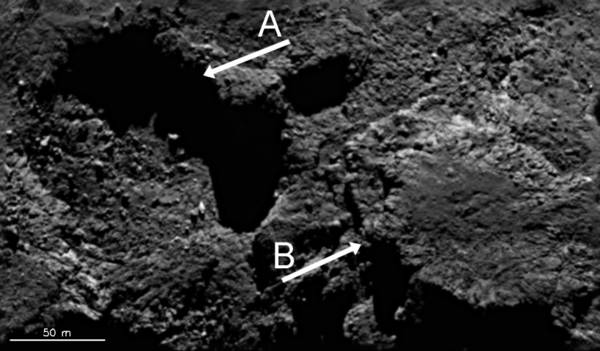What'sNEW
January - March 2015
We present data supporting the presence of an indigenous source of fixed nitrogen on the surface of Mars in the form of nitrate. This is the finding of an international team analyzing data from NASA's Curiosity rover. Fixed nitrogen is necessary for life on Earth, where bacteria accomplish the fixing. However, the NASA-affiliated team cautiously speculate, The detection of nitrate ...is likely a result of N2 fixation to nitrate generated by thermal shock from impact or volcanic plume lightning on ancient Mars. Of course, they are aware that nitrates are a biochemically accessible source of nitrogen. These data strengthen the case that Mars has hosted life.
 Jennifer C. Stern et al., "Evidence for indigenous nitrogen in sedimentary and aeolian deposits from the Curiosity rover investigations at Gale crater, Mars" [abstract], doi:10.1073/pnas.1420932112, PNAS, online 23 Mar 2015. Jennifer C. Stern et al., "Evidence for indigenous nitrogen in sedimentary and aeolian deposits from the Curiosity rover investigations at Gale crater, Mars" [abstract], doi:10.1073/pnas.1420932112, PNAS, online 23 Mar 2015.
 Curiosity Rover Finds Biologically Useful Nitrogen on Mars, JPL News Release 2015-096, 24 Mar 2015. Curiosity Rover Finds Biologically Useful Nitrogen on Mars, JPL News Release 2015-096, 24 Mar 2015.
 Eric Hand, "'Fixed' nitrogen found in martian soil" [summary], doi:10.1126/science.347.6229.1403-a, Science, 27 Mar 2015. Eric Hand, "'Fixed' nitrogen found in martian soil" [summary], doi:10.1126/science.347.6229.1403-a, Science, 27 Mar 2015.
 Thanks, Sascha Wageringel, for an alert and Thanks, Sascha Wageringel, for an alert and  comments, 26 Mar 2015. comments, 26 Mar 2015.
 Life on Mars! is a related CA webpage. Life on Mars! is a related CA webpage.
Origin-of-life puzzle cracked. That's the title of commentary in Science about research by a team at Cambridge, UK. The researchers begin by commenting, A minimal cell can be thought of as comprising informational, compartment-forming and metabolic subsystems. To imagine the abiotic assembly of such an overall system, however, places great demands on hypothetical prebiotic chemistry. Right. Responding to these demands, they observe that precursors of ribonucleotides, amino acids and lipids can all be derived by the reductive homologation of hydrogen cyanide and some of its derivatives, and thus ... all the cellular subsystems could have arisen simultaneously through common chemistry. If the ingredients can all come from similar chemistry, perhaps the process can be compressed.
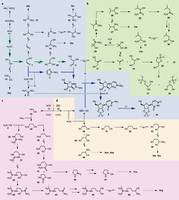
...Slight variations in chemistry and energy could have favored the creation of one set of building blocks or another in different places on land. "Rainwater would then wash these compounds into a common pool," says Dave Deamer, an origin-of-life researcher at the University of California, Santa Cruz. The new research adds another suggestion to the mix for the hardware problem. The software problem gets no mention, as usual. We think the puzzle remains undiminished.
 Bhavesh H. Patel et al., "Common origins of RNA, protein and lipid precursors in a cyanosulfidic protometabolism" [abstract], doi:10.1038/nchem.2202, Nature Chemistry, online 16 Mar 2015. Bhavesh H. Patel et al., "Common origins of RNA, protein and lipid precursors in a cyanosulfidic protometabolism" [abstract], doi:10.1038/nchem.2202, Nature Chemistry, online 16 Mar 2015.
 Robert F. Service, "Origin-of-life puzzle cracked" [summary], doi:10.1126/science.347.6228.1298, p 1298 v 347, Science, 20 Mar 2015. Robert F. Service, "Origin-of-life puzzle cracked" [summary], doi:10.1126/science.347.6228.1298, p 1298 v 347, Science, 20 Mar 2015.
 Nicholas Wade, Making Sense of the Chemistry That Led to Life on Earth, The New York Times, 5 May 2015. "The RNA World is burdened with several unresolved paradoxes." Nicholas Wade, Making Sense of the Chemistry That Led to Life on Earth, The New York Times, 5 May 2015. "The RNA World is burdened with several unresolved paradoxes."
 On the Origins of Life by Jef Akst, The Scientist, 17 Mar 2015. On the Origins of Life by Jef Akst, The Scientist, 17 Mar 2015.
 Thanks, Google Alerts and Stan Franklin. Thanks, Google Alerts and Stan Franklin.
 The RNA World And Other Origin-of-Life Theories is the main related CA webpage. The RNA World And Other Origin-of-Life Theories is the main related CA webpage.
We develop the first catalogue, to our knowledge, of reflectance spectra for a diverse range of pigmented microorganisms, including ones that were isolated from Earth's most extreme environments. This catalogue provides a broad scope of surface signatures for life on exoplanets....
 Siddharth Hegde, et al., "Surface biosignatures of exo-Earths: Remote detection of extraterrestrial life" [abstract], doi:10.1073/pnas.1421237112, PNAS, online 16 Mar 2015. Siddharth Hegde, et al., "Surface biosignatures of exo-Earths: Remote detection of extraterrestrial life" [abstract], doi:10.1073/pnas.1421237112, PNAS, online 16 Mar 2015.
 The Astonishing Redness of Kuiper-Belt Objects is a related preprint, by Wickramasinghe and Hoyle, 1999. The Astonishing Redness of Kuiper-Belt Objects is a related preprint, by Wickramasinghe and Hoyle, 1999.
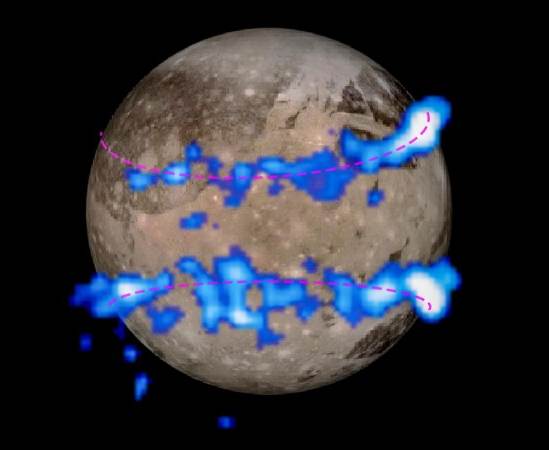 Ganymede has more ocean water than Earth, according to an analysis of observations from the Hubble Space Telescope. Ganymede's magnetic field... produces two auroral belts (pictured) that can be detected in the ultraviolet. These fluctuate as the big moon orbits within Jupiter's magnetic field. The auroral flucuations are most accurately explained if a conducting (saltwater) ocean on Ganymede also influences them. NASA thinks life might be found there.
Ganymede has more ocean water than Earth, according to an analysis of observations from the Hubble Space Telescope. Ganymede's magnetic field... produces two auroral belts (pictured) that can be detected in the ultraviolet. These fluctuate as the big moon orbits within Jupiter's magnetic field. The auroral flucuations are most accurately explained if a conducting (saltwater) ocean on Ganymede also influences them. NASA thinks life might be found there.
 Saur, J., et al., "The search for a subsurface ocean in Ganymede with Hubble Space Telescope observations of its auroral ovals" [abstract], doi:10.1002/2014JA020778, J. Geophys. Res., 12 Mar 2015. Saur, J., et al., "The search for a subsurface ocean in Ganymede with Hubble Space Telescope observations of its auroral ovals" [abstract], doi:10.1002/2014JA020778, J. Geophys. Res., 12 Mar 2015.
 NASA's Hubble Observations Suggest Underground Ocean on Jupiter's Largest Moon, News Release STScI-2015-09, Hubblesite.org (+Newswise +NASA +Science), 12 Mar 2015. NASA's Hubble Observations Suggest Underground Ocean on Jupiter's Largest Moon, News Release STScI-2015-09, Hubblesite.org (+Newswise +NASA +Science), 12 Mar 2015.
 Life on Europa, Other Moons, Other Planets?... has many related links. Life on Europa, Other Moons, Other Planets?... has many related links.
 Wickramasinghe NC, Wainwright M, Smith WE, Tokoro G, Al Mufti S, et al., "Rosetta Studies of Comet 67P/Churyumov–Gerasimenko: Prospects for Establishing Cometary Biology" [abstract | pdf], doi:10.4172/2332-2519.1000126, n 126 v 3, Astrobiol Outreach, online 9 Feb 2015. Wickramasinghe NC, Wainwright M, Smith WE, Tokoro G, Al Mufti S, et al., "Rosetta Studies of Comet 67P/Churyumov–Gerasimenko: Prospects for Establishing Cometary Biology" [abstract | pdf], doi:10.4172/2332-2519.1000126, n 126 v 3, Astrobiol Outreach, online 9 Feb 2015.
 Comet Rendezvous has a What'sNEW section with links to more news about Rosetta. Comet Rendezvous has a What'sNEW section with links to more news about Rosetta.
| 12 Mar 2015 |
What'sNEW about HGT  | | |
We argue that HGT has occurred, and continues to occur, on a previously unsuspected scale in metazoans....

 Alastair Crisp, Chiara Boschetti et al., "Expression of multiple horizontally acquired genes is a hallmark of both vertebrate and invertebrate genomes" [html], doi:10.1186/s13059-015-0607-3, Genome Biology, 13 Mar 2015. Alastair Crisp, Chiara Boschetti et al., "Expression of multiple horizontally acquired genes is a hallmark of both vertebrate and invertebrate genomes" [html], doi:10.1186/s13059-015-0607-3, Genome Biology, 13 Mar 2015.
 "Genetically modified people," The Economist, 14 Mar 2015. "Genetically modified people," The Economist, 14 Mar 2015.
 Humans may harbor more than 100 genes from other organisms by Sarah C. P. Williams, Science News, 12 Mar 2015. Humans may harbor more than 100 genes from other organisms by Sarah C. P. Williams, Science News, 12 Mar 2015.
 Some genes 'foreign' in origin and not from our ancestors, PhysOrg.com, 12 Mar 2015. Some genes 'foreign' in origin and not from our ancestors, PhysOrg.com, 12 Mar 2015.
 Horizontal Gene Transfer a Hallmark of Animal Genomes? by Jyoti Madhusoodanan, The Scientist, 12 Mar 2015. Horizontal Gene Transfer a Hallmark of Animal Genomes? by Jyoti Madhusoodanan, The Scientist, 12 Mar 2015.
 The movement of DNA from one species to another, Biome (BioMed Central), 18 Mar 2015. The movement of DNA from one species to another, Biome (BioMed Central), 18 Mar 2015.
 Thanks, Google Alerts and Stan Franklin. Thanks, Google Alerts and Stan Franklin.
 Human Genome Search is a related local webpage. Human Genome Search is a related local webpage.
 Viruses and Other Gene Transfer Mechanisms is a related CA webpage. Viruses and Other Gene Transfer Mechanisms is a related CA webpage.
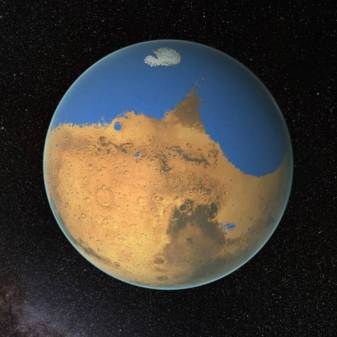 A primitive ocean on Mars held more water than Earth's Arctic Ocean, according to NASA scientists. Using ground-based telescopes, NASA can see that the ratio of deuterium to hydrogen in water on Mars varies from place to place. And these D/H ratios are different from that in martian meteorites recovered on Earth. The differences are best explained if Mars lost a large volume of water to space over millions of years.
A primitive ocean on Mars held more water than Earth's Arctic Ocean, according to NASA scientists. Using ground-based telescopes, NASA can see that the ratio of deuterium to hydrogen in water on Mars varies from place to place. And these D/H ratios are different from that in martian meteorites recovered on Earth. The differences are best explained if Mars lost a large volume of water to space over millions of years.
 G. L. Villanueva et al., "Strong water isotopic anomalies in the martian atmosphere: Probing current and ancient reservoirs" [abstract], doi:10.1126/science.aaa3630, Science, online 5 Mar 2015. G. L. Villanueva et al., "Strong water isotopic anomalies in the martian atmosphere: Probing current and ancient reservoirs" [abstract], doi:10.1126/science.aaa3630, Science, online 5 Mar 2015.
 NASA Research Suggests Mars Once Had More Water than Earth's Arctic Ocean, NASA News Release 15-032, 5 Mar 2015. NASA Research Suggests Mars Once Had More Water than Earth's Arctic Ocean, NASA News Release 15-032, 5 Mar 2015.
 Mars may have formed with enough water...: What'sNEW, 15 Dec 2001. Mars may have formed with enough water...: What'sNEW, 15 Dec 2001.
 Thanks, Sascha Wageringel, who is "starting to wonder if there is evidence for ancient reefs." Thanks, Sascha Wageringel, who is "starting to wonder if there is evidence for ancient reefs."
...For most of the functional signature systems of the eukaryotic cells, we can detect no evolutionary intermediates.
 Eugene V. Koonin, The Logic of Chance: The Nature and Origin of Biological Evolution, 2011 (reviewed in What'sNEW, 20 Dec 2013.) Eugene V. Koonin, The Logic of Chance: The Nature and Origin of Biological Evolution, 2011 (reviewed in What'sNEW, 20 Dec 2013.)
 New genetic programs in Darwinism and strong panspermia: Koonin's statement supports our prediction of Apr 2002. New genetic programs in Darwinism and strong panspermia: Koonin's statement supports our prediction of Apr 2002.
News about the mission to Ceres:
 NASA Spacecraft Becomes First to Orbit a Dwarf Planet, NASA News Release 15-034, 6 Mar 2015. NASA Spacecraft Becomes First to Orbit a Dwarf Planet, NASA News Release 15-034, 6 Mar 2015.
 Spacecraft nears dwarf planet Ceres by Alexandra Witze, Nature News, 3 Mar 2015. Spacecraft nears dwarf planet Ceres by Alexandra Witze, Nature News, 3 Mar 2015.
 Dark Craters and Bright Spots Revealed on Asteroid Ceres, Astronomy Picture of the Day, 18 Feb 2015. Dark Craters and Bright Spots Revealed on Asteroid Ceres, Astronomy Picture of the Day, 18 Feb 2015.
 Eric Hand, "Dawn probe to look for a habitable ocean on Ceres" [summary], doi:10.1126/science.347.6224.813, Science, 20 Feb 2015. Eric Hand, "Dawn probe to look for a habitable ocean on Ceres" [summary], doi:10.1126/science.347.6224.813, Science, 20 Feb 2015.
...And possible ones to Europa and Enceladus:
 Eric Hand, "Plumes on Europa tease NASA mission planners" [summary], doi:10.1126/science.347.6225.932, Science, 27 Feb 2015. Eric Hand, "Plumes on Europa tease NASA mission planners" [summary], doi:10.1126/science.347.6225.932, Science, 27 Feb 2015.
 McKay Christopher P., Anbar Ariel D., Porco Carolyn, and Tsou Peter, "Follow the Plume: The Habitability of Enceladus" [link], doi:10.1089/ast.2014.1158, Astrobiology, Apr 2015. McKay Christopher P., Anbar Ariel D., Porco Carolyn, and Tsou Peter, "Follow the Plume: The Habitability of Enceladus" [link], doi:10.1089/ast.2014.1158, Astrobiology, Apr 2015.
 Thanks, William Smith. Thanks, William Smith.
 Life on Europa, Other Moons, Other Planets?... has these and many related links. Life on Europa, Other Moons, Other Planets?... has these and many related links.
Our results demonstrate that natural selection can rapidly rewire regulatory networks in very few, repeatable mutational steps. This is the valid conclusion of an international team conducting quarantined experiments with the bacterium Pseudomonas fluorescens. Taylor, Mulley et al. knocked out a regulatory gene, thus disabling the growth of the bacterial flagella. To their surprise, another regulator took up the job and flagella grew again.
 This is a fascinating set of evolution experiments, evolutionary biologist Richard Lenski told The Scientist. Their experiments show how a biological function ...can re-evolve after the deletion of a seemingly critical gene. At Michigan State University, Lenski himself initiated the best-known quarantined experiments with bacteria. Among many objectives, the experimenters hope to observe the invention of new genetic programs.
This is a fascinating set of evolution experiments, evolutionary biologist Richard Lenski told The Scientist. Their experiments show how a biological function ...can re-evolve after the deletion of a seemingly critical gene. At Michigan State University, Lenski himself initiated the best-known quarantined experiments with bacteria. Among many objectives, the experimenters hope to observe the invention of new genetic programs.
So far, the team at MSU have not observed this phenomenon. In spite of hype by Lenski and The Scientist, neither have Taylor, Mulley et al. Point mutations in pre-existing regulatory genes re-enabled the pre-existing, complex programs for flagella. And these mutations caused other deleterious effects. For an elaboration on this scepticism, see biochemist Michael Behe's comments. He is, at least, an expert on the bacterial flagellum.
 Tiffany B. Taylor, Geraldine Mulley et al., "Evolutionary resurrection of flagellar motility via rewiring of the nitrogen regulation system" [abstract], doi:10.1126/science.1259145, p 1014-1017 v 347, Science, 27 Feb 2015. Tiffany B. Taylor, Geraldine Mulley et al., "Evolutionary resurrection of flagellar motility via rewiring of the nitrogen regulation system" [abstract], doi:10.1126/science.1259145, p 1014-1017 v 347, Science, 27 Feb 2015.
 Evolutionary Rewiring by Ruth Williams, The Scientist, 26 Feb 2015. Evolutionary Rewiring by Ruth Williams, The Scientist, 26 Feb 2015.
 Thanks, Ken Jopp. Thanks, Ken Jopp.
 "Resurrected" Flagella Were Just Unplugged by Michael Behe, Evolution News, 3 Mar 2015. "Resurrected" Flagella Were Just Unplugged by Michael Behe, Evolution News, 3 Mar 2015.
 ...Is Evolutionary Progress in a Closed System Possible? has a special What'sNEW section, Lenski et al. ...Is Evolutionary Progress in a Closed System Possible? has a special What'sNEW section, Lenski et al.
 Dr. George Nickas points to research supporting Hoyle and Wickramasinghe's thesis on airborne pathogens, 2 Mar 2015. Dr. George Nickas points to research supporting Hoyle and Wickramasinghe's thesis on airborne pathogens, 2 Mar 2015.
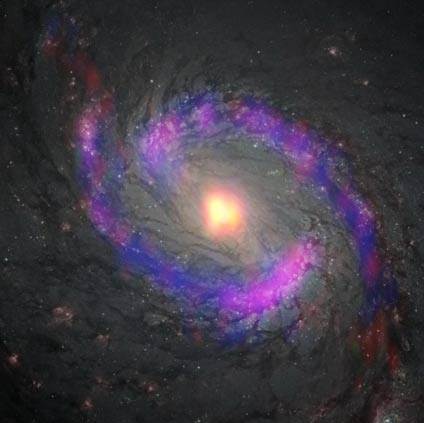 Astronomers assumed that such regions would therefore be devoid of such complex organics. The ALMA observations, however, proved the contrary: Complex organic molecules are abundant in the CND.... CND stands for circumnuclear disk, a ring of dust and gas surrounding, in this case, the supermassive black hole at the center of galaxy NGC 1068 (pictured). Seen there by researchers using the Atacama Large Millimeter/ submillimeter Array (ALMA) are complex organic molecules such as cyanoacetylene (HC3N) and acetonitrile (CH3CN), carbon monosulfide (CS) and methanol (CH3OH). Such complex carbon-based molecules are thought to be easily obliterated by the strong X-rays and ultraviolet (UV) photons that permeate the environment surrounding supermassive black holes. The new ALMA data indicate, however, that pockets of calm exist even in this tumultuous region, most likely due to dense areas of dust and gas that shield molecules from otherwise lethal radiation. As usual, the possibility that the complex organics are degraded byproducts of life is not mentioned.
Astronomers assumed that such regions would therefore be devoid of such complex organics. The ALMA observations, however, proved the contrary: Complex organic molecules are abundant in the CND.... CND stands for circumnuclear disk, a ring of dust and gas surrounding, in this case, the supermassive black hole at the center of galaxy NGC 1068 (pictured). Seen there by researchers using the Atacama Large Millimeter/ submillimeter Array (ALMA) are complex organic molecules such as cyanoacetylene (HC3N) and acetonitrile (CH3CN), carbon monosulfide (CS) and methanol (CH3OH). Such complex carbon-based molecules are thought to be easily obliterated by the strong X-rays and ultraviolet (UV) photons that permeate the environment surrounding supermassive black holes. The new ALMA data indicate, however, that pockets of calm exist even in this tumultuous region, most likely due to dense areas of dust and gas that shield molecules from otherwise lethal radiation. As usual, the possibility that the complex organics are degraded byproducts of life is not mentioned.
 Shuro Takano et al., "Distributions of molecules in the circumnuclear disk and surrounding starburst ring in the Seyfert galaxy NGC 1068 observed with ALMA" [abstract], doi:10.1093/pasj/psu052, Publ Astron Soc Jpn, Aug 2014. Shuro Takano et al., "Distributions of molecules in the circumnuclear disk and surrounding starburst ring in the Seyfert galaxy NGC 1068 observed with ALMA" [abstract], doi:10.1093/pasj/psu052, Publ Astron Soc Jpn, Aug 2014.
 Taku Nakajima et al., "A Multi-Transition Study of Molecules toward NGC 1068 based on High-Resolution Imaging Observations with ALMA" [abstract | pdf], arXiv:1410.5912 [astro-ph.GA], 22 Oct 2014. Taku Nakajima et al., "A Multi-Transition Study of Molecules toward NGC 1068 based on High-Resolution Imaging Observations with ALMA" [abstract | pdf], arXiv:1410.5912 [astro-ph.GA], 22 Oct 2014.
 Pockets of Calm Protect Molecules Around a Supermassive Black Hole, National Radio Astronomy Observatory (+Newswise), 26 Feb 2015. Pockets of Calm Protect Molecules Around a Supermassive Black Hole, National Radio Astronomy Observatory (+Newswise), 26 Feb 2015.
 Hoyle and Wickramasinghe's Analysis of Interstellar Dust is a related local webpage. Hoyle and Wickramasinghe's Analysis of Interstellar Dust is a related local webpage.
The second law essentially says that the universe must have had a beginning and an end. That's very difficult to accept. The universe must be timeless, for if there was a beginning, what was before the beginning? Something cannot come out of nothing.... So writes Bruce Parker of the Stevens Institute of Technology, in an essay titled Entropy. It is his response to the prompt, Scientific Ideas That Are Blocking Progress, the subtitle of a new book from John Brockman of Edge.org. In this collection, 175 scientists, writers and celebrities briefly respond to that prompt, sometimes in unrestrained rants. They may include questionable opinions, such as Parker's own "Complexity is synonymous with low entropy." (Randomness - maximally complex - has high entropy.) Still, we agree, nothing comes from nothing. The book is fun to peruse, and we have just started. Some of the other 174 ideas deemed to need retirement:

 The Big Bang Was the First Moment of Time, by Lee Smolin The Big Bang Was the First Moment of Time, by Lee Smolin
 Essentialism, by Richard Dawkins: "...Any evolutionist knows that there must have existed individuals who were exactly intermediate." Essentialism, by Richard Dawkins: "...Any evolutionist knows that there must have existed individuals who were exactly intermediate."
 Evolution is "True", by Roger Highfield: "We also need to abandon the blind adherence to the idea that the mechanisms of evolution are truths that lie beyond discussion." Evolution is "True", by Roger Highfield: "We also need to abandon the blind adherence to the idea that the mechanisms of evolution are truths that lie beyond discussion."
 Infinity, by Max Tegmark Infinity, by Max Tegmark
 Science Makes Philosophy Obsolete, by Rebecca Newberger Goldstein Science Makes Philosophy Obsolete, by Rebecca Newberger Goldstein
 Common Sense, by Robert Provine Common Sense, by Robert Provine
 Life Evolves Via a Shared Genetic Toolkit, by Seirian Sumner: "...Each new genome brings with it a suite of unique genes." Life Evolves Via a Shared Genetic Toolkit, by Seirian Sumner: "...Each new genome brings with it a suite of unique genes."
 Fully Random Mutations, by Kevin Kelly: "For instance, it's pretty much accepted that mutation rates increase or decrease as stress on the cells increases or decreases." Fully Random Mutations, by Kevin Kelly: "For instance, it's pretty much accepted that mutation rates increase or decrease as stress on the cells increases or decreases."
 Science Is Self-Correcting, by Alex Holcombe Science Is Self-Correcting, by Alex Holcombe
 Only Scientists Can Do Science, by Kate Mills Only Scientists Can Do Science, by Kate Mills
 Human Evolutionary Exceptionalism, by Michael McCullough Human Evolutionary Exceptionalism, by Michael McCullough
Other contributors include Alan Guth, Andrei Linde, Frank Tipler, Freeman Dyson, Michael Shermer, Sean Carroll, Daniel C. Dennett, Susan Blackmore, Alan Alda, Steven Pinker, Paul Davies, Dimitar Sasselov, Martin Nowak, Steve Fuller and Jared Diamond. Many more. Someone for everyone.
 John Brockman, ed., This Idea Must Die, Harper Collins, 17 Feb 2015. John Brockman, ed., This Idea Must Die, Harper Collins, 17 Feb 2015.
 The Second Law of Thermodynamics and The Second Law of Thermodynamics and  The End and the Big Bang are related to Parker's Entropy. The End and the Big Bang are related to Parker's Entropy.
The short answer is Life is a DNA software-driven system, at least on this planet, as far as we know. Every species is driven by their DNA software, totally and completely. ...Without the software, you can't make new hardware. Craig Venter, who pioneered methods used for sequencing the human genome, gives this answer to the question, What is Life? And when asked about the project to sequence one million genomes by 2020, he first replied, The challenge is trying to learn how to read that software that we have.
Eight years ago we approached Venter to ask for his thoughts on where the software comes from, but he was not willing to reply to that one. Apparently, evolution is a subject he avoids. Gridlocked as the subject is, avoiding it is understandable, but unfortunate.
 J. Craig Venter on DNA and Life's Mysteries, interview with John Bussey, The Wall Street Journal, 9 Feb 2015. J. Craig Venter on DNA and Life's Mysteries, interview with John Bussey, The Wall Street Journal, 9 Feb 2015.
 What Is Life? and What Is Life? and
 Sequencing the Genome are related sections of this website. Sequencing the Genome are related sections of this website.
In the video accompanying the article, Venter says that Mars definitely had life, and it would resemble life as we know it. Furthermore, the best way to look for life on Mars is to send DNA sequencing equipment. The DNA sequence of a martian bacterium could be transmitted back to Earth, where we could grow its clone for study. Wow.
 Life on Mars! is a related CA webpage. Life on Mars! is a related CA webpage.
 NASA Plans to Search for Life on Jupiter's Europa (2 min. video) by Monika Auger, The Wall Street Journal, 3 Feb 2015. NASA Plans to Search for Life on Jupiter's Europa (2 min. video) by Monika Auger, The Wall Street Journal, 3 Feb 2015.
 ...A mission to Jupiter's moon? (with short videos), Global News, Canada, 5 Feb 2015. ...A mission to Jupiter's moon? (with short videos), Global News, Canada, 5 Feb 2015.
 Life on Europa, Other Moons, Other Planets?... has related links. Life on Europa, Other Moons, Other Planets?... has related links.
 Thanks, Bill Smith. Thanks, Bill Smith.
 Dimitar Sasselov's Online Course on Alien Life, the Harvard Origins of Life Initiative, available 10 Feb 2015. Dimitar Sasselov's Online Course on Alien Life, the Harvard Origins of Life Initiative, available 10 Feb 2015.
| 30 Jan 2015 |
What'sNEW about HGT  | | |
I guess we owe the evolution of pregnancy to what are effectively genomic parasites. Vincent Lynch of The University of Chicago makes this comment after a comprehensive analysis of the genes underlying pregnancy in mammals. Several thousand of the genes were recruited from unrelated roles, and re-regulated by transposable elements (TEs, the above-mentioned parasites.)
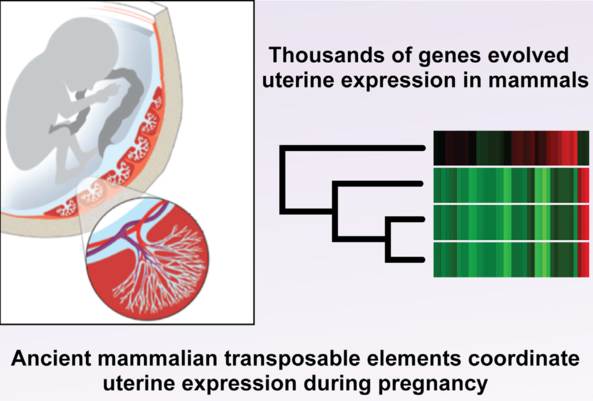
These data indicate that a defining evolutionary novelty in mammals evolved through the recruitment and loss of ancient genes into an evolutionarily novel tissue, primarily via TE-mediated origination of a new cis-regulatory landscape in endometrial stromal cells.
Thousands of ancient genes simultaneously repurposed and re-regulated by invasive TEs? Such complex, coordinated steps must have relied on powerful genetic programming. It strains credulity to suggest that the programming was suddenly, incrementally composed by darwinian trial-and-error. The programming must have been available already.
 Vincent J. Lynch et al., "Ancient Transposable Elements Transformed the Uterine Regulatory Landscape and Transcriptome during the Evolution of Mammalian Pregnancy" [open access abstract], doi:10.1016/j.celrep.2014.12.052, Cell Reports, online 29 Jan 2015. Vincent J. Lynch et al., "Ancient Transposable Elements Transformed the Uterine Regulatory Landscape and Transcriptome during the Evolution of Mammalian Pregnancy" [open access abstract], doi:10.1016/j.celrep.2014.12.052, Cell Reports, online 29 Jan 2015.
 Ancient "genomic parasites" spurred evolution of pregnancy in mammals, The University of Chicago Medicine (+ScienceDaily), 29 Jan 2015. Ancient "genomic parasites" spurred evolution of pregnancy in mammals, The University of Chicago Medicine (+ScienceDaily), 29 Jan 2015.
 How Transposons Shaped Pregnancy, The Scientist, 29 Jan 2015. How Transposons Shaped Pregnancy, The Scientist, 29 Jan 2015.
 Thanks, Jeff Krolick. Thanks, Jeff Krolick.
 More than 1500 genes ...recruited into service is a related What'sNEW article, 26 Sep 2011. More than 1500 genes ...recruited into service is a related What'sNEW article, 26 Sep 2011.
 Placental genes have ancient origins is a related What'sNEW article, 21 Apr 2008. Placental genes have ancient origins is a related What'sNEW article, 21 Apr 2008.
 Viruses and Other Gene Transfer Mechanisms is the main related CA webpage. Viruses and Other Gene Transfer Mechanisms is the main related CA webpage.
On the left (position A) there is a 150 m diameter pit. To the right (position B) is a similar sized block sitting on the surface. This is the caption for a picture from a supplement to one of eight online articles about comet 67P. It caught our attention because of the story it tells.
Gas pressure must have built up underground until it erupted, throwing over a big slab of surface material. Of course, bacterial metabolism produces gasses, such as methane. Other evidence from this mission, including H2O venting, and surface features that look like silt-washes or mud-oozes, suggest that liquid water would be available for bacterial metabolism. We think this evidence bolsters the case for cometary panspermia.
 Nicolas Thomas et al., "The morphological diversity of comet 67P/Churyumov-Gerasimenko" [abstract | supplement], doi:10.1126/science.aaa0440, Science, 23 Jan 2015. Nicolas Thomas et al., "The morphological diversity of comet 67P/Churyumov-Gerasimenko" [abstract | supplement], doi:10.1126/science.aaa0440, Science, 23 Jan 2015.
 After rendezvous, the Rosetta spacecraft moved ...to a bound orbit only ~10 km away. This early period of the mission has revealed previously unseen details of a comet nucleus, as Rosetta's instruments recorded measurements that were once impossible. This issue of Science contains the first published scientific results from Rosetta at comet 67P.
After rendezvous, the Rosetta spacecraft moved ...to a bound orbit only ~10 km away. This early period of the mission has revealed previously unseen details of a comet nucleus, as Rosetta's instruments recorded measurements that were once impossible. This issue of Science contains the first published scientific results from Rosetta at comet 67P.
 Eric Hand, "Comet close-up reveals a world of surprises" [text], p 358-359; and Eric Hand, "Comet close-up reveals a world of surprises" [text], p 358-359; and
 M. G. G. T. Taylor et al., "Rosetta begins its Comet Tale" [text with links], p 387 v 347, Science [Table of Contents], 23 Jan 2015. M. G. G. T. Taylor et al., "Rosetta begins its Comet Tale" [text with links], p 387 v 347, Science [Table of Contents], 23 Jan 2015.
 Ten new Rosetta images..., Science News, 22 Jan 2015. Ten new Rosetta images..., Science News, 22 Jan 2015.
 Getting to Know Rosetta's Comet, ESA, 22 Jan 2015. Getting to Know Rosetta's Comet, ESA, 22 Jan 2015.
 ...Discoveries Revealed by Rosetta Spacecraft, Space.com, 22 Jan 2015. ...Discoveries Revealed by Rosetta Spacecraft, Space.com, 22 Jan 2015.
 ...Evidence for building blocks of life on comet, Global News, Canada, 22 Jan 2015. ...Evidence for building blocks of life on comet, Global News, Canada, 22 Jan 2015.
 Science pours in from Rosetta comet mission and Science pours in from Rosetta comet mission and
 Hunt for Philae hangs in the balance by Elizabeth Gibney, Nature News, 22-23 Jan 2015. Hunt for Philae hangs in the balance by Elizabeth Gibney, Nature News, 22-23 Jan 2015.
 Comets... and Comets... and
 Comet Rendezvous have more. Comet Rendezvous have more.
 15 Dec 2018: Weather on a Comet? A brief movie seems to show a blizzard.... 15 Dec 2018: Weather on a Comet? A brief movie seems to show a blizzard....
 Thanks for alerts, Bill Smith, Larry Klaes and Sascha Wageringel. Thanks for alerts, Bill Smith, Larry Klaes and Sascha Wageringel.
| 19 Jan 2015 |
What'sNEW about HGT  | | |
 | |
...Upon initial attachment (I), the bacteria form a three-dimensional biofilm (II) on the chitinous surface, thereby reaching high cell density (HCD). Within these biofilms, different V. cholerae strains carrying diverse and noncompatible effector-immunity modules (shown by the different colors of bacteria) most likely form mixed communities (III). Under such chitin-dependent and HCD conditions, V. cholerae induces its natural competence program. In this study, we showed that the T6SS (indicated by the red arrow) is part of the competence regulon and induced upon the growth of V. cholerae on chitin substrates. The T6SS is active against nonimmune neighboring cells (IV), leading to their lysis (V). The DNA released by the lysed cells can be taken up by a competent predator cell (VI), leading to its natural transformation and evolution in the case that new DNA material is incorporated (VII). |
...Deliberate killing of nonimmune cells ...releases DNA and makes it accessible for horizontal gene transfer in V. cholerae. After growing on the molted, chitinous exosksletons of planktonic crustaceans, these bacteria can actively initiate the acquisition of new genes. In other words, they can deliberately stimulate HGT from other bacteria to themselves.
 Sandrine Borgeaud et al., "The type VI secretion system of Vibrio cholerae fosters horizontal gene transfer" [abstract], doi:10.1126/science.1260064, p 63-67 v 347, Science, 2 Jan 2015. Sandrine Borgeaud et al., "The type VI secretion system of Vibrio cholerae fosters horizontal gene transfer" [abstract], doi:10.1126/science.1260064, p 63-67 v 347, Science, 2 Jan 2015.
 ...Transfer is controlled by and initiated by signals sent from the recipient, a different example, mentioned in What'sNEW, 7 Jul 2014. ...Transfer is controlled by and initiated by signals sent from the recipient, a different example, mentioned in What'sNEW, 7 Jul 2014.
 Viruses and Other Gene Transfer Mechanisms is the main related CA webpage. Viruses and Other Gene Transfer Mechanisms is the main related CA webpage.
Bacterial gene swapping, called horizontal gene transfer by microbiologists, is like a messy game of telephone.
 Bacteria's Game of 'Telephone' Foils Microbiologists' Eavesdropping by Kim Krieger, University of Connecticut, 8 Dec 2014. Bacteria's Game of 'Telephone' Foils Microbiologists' Eavesdropping by Kim Krieger, University of Connecticut, 8 Dec 2014.
 Sophie M. Colston, Matthew S. Fullmer et al., "Bioinformatic Genome Comparisons for Taxonomic and Phylogenetic Assignments Using Aeromonas as a Test Case" [html], doi:10.1128/mBio.02136-14, mBio, 18 Nov 2014. Sophie M. Colston, Matthew S. Fullmer et al., "Bioinformatic Genome Comparisons for Taxonomic and Phylogenetic Assignments Using Aeromonas as a Test Case" [html], doi:10.1128/mBio.02136-14, mBio, 18 Nov 2014.
 The Tree of Life is a related CA webpage.
Bacteria are like smartphones. Each phone comes out of the factory with standard hardware and operating system (core genome), but gains a unique combination of capabilities through apps (accessory genes) downloaded through the internet (by horizontal gene transfer). The Tree of Life is a related CA webpage.
Bacteria are like smartphones. Each phone comes out of the factory with standard hardware and operating system (core genome), but gains a unique combination of capabilities through apps (accessory genes) downloaded through the internet (by horizontal gene transfer).
 Nitin Kumar et al., "Bacterial genospecies that are not ecologically coherent: population genomics of Rhizobium leguminosarum" [html], doi:10.1098/rsob.140133, Open Biology, 14 Jan 2015. Nitin Kumar et al., "Bacterial genospecies that are not ecologically coherent: population genomics of Rhizobium leguminosarum" [html], doi:10.1098/rsob.140133, Open Biology, 14 Jan 2015.
 Understanding the personalities of bacteria, University of York (+International Business Times +PhysOrg.com), 14 Jan 2015. Understanding the personalities of bacteria, University of York (+International Business Times +PhysOrg.com), 14 Jan 2015.
 What Is Life? is a CA webpage explaining, "A cell is like a computer." What Is Life? is a CA webpage explaining, "A cell is like a computer."
 Thanks, Google Alerts. Thanks, Google Alerts.
| 13 Jan 2015 |
What'sNEW about HGT  | | |
A new study from Lund University in Sweden indicates that inherited viruses that are millions of years old play an important role in building up the complex networks that characterise the human brain.
 Liana Fasching et al., "TRIM28 Represses Transcription of Endogenous
Retroviruses in Neural Progenitor Cells" [abstract | PubMed | pdf], doi:10.1016/j.celrep.2014.12.00, p 20-28 v 10, Cell Reports, 6 Jan 2015. Liana Fasching et al., "TRIM28 Represses Transcription of Endogenous
Retroviruses in Neural Progenitor Cells" [abstract | PubMed | pdf], doi:10.1016/j.celrep.2014.12.00, p 20-28 v 10, Cell Reports, 6 Jan 2015.
 Do viruses make us smarter?, Lund University (+ScienceDaily), 12 Jan 2015. Do viruses make us smarter?, Lund University (+ScienceDaily), 12 Jan 2015.
 Thanks, Ted Rigley! Thanks, Ted Rigley!
 Viruses and Other Gene Transfer Mechanisms is the main related CA webpage. Viruses and Other Gene Transfer Mechanisms is the main related CA webpage.
 Human Genome Search... and Human Genome Search... and  New genetic programs... are related CA webpages. New genetic programs... are related CA webpages.
The "Breakthrough of the Year" was the comet rendezvous by ESA's Rosetta mission, according to Science.
 Eric Hand, "Comet Breakthrough of the Year...," p 1442-1443 v 346, Science, 19 Dec 2014. Eric Hand, "Comet Breakthrough of the Year...," p 1442-1443 v 346, Science, 19 Dec 2014.
 Updates as Philae landed on Comet 67P, What'sNEW, 11-19 Nov 2014. Updates as Philae landed on Comet 67P, What'sNEW, 11-19 Nov 2014.
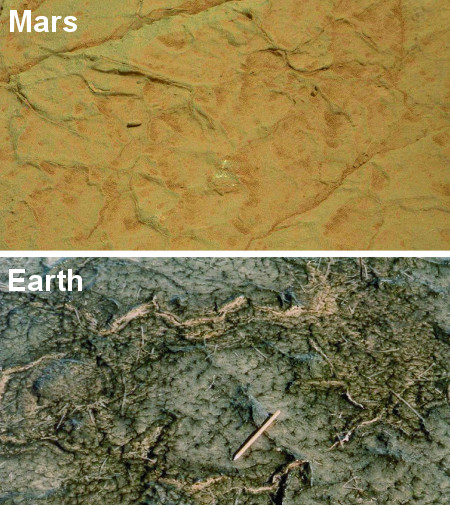 Rocks photographed by NASA's Curiosity rover on Mars resemble biologically formed ones on Earth, according to geobiologist Nora Noffke of Old Dominion University in Virginia. In a paper in Astrobiology, Noffke carefully compares sedimentary structures in Mars' Gillespie Lake outcrop with structures shaped by microbes on Earth. The study is worth a look:
Rocks photographed by NASA's Curiosity rover on Mars resemble biologically formed ones on Earth, according to geobiologist Nora Noffke of Old Dominion University in Virginia. In a paper in Astrobiology, Noffke carefully compares sedimentary structures in Mars' Gillespie Lake outcrop with structures shaped by microbes on Earth. The study is worth a look:
 Nora Noffke, "Ancient Sedimentary Structures in the <3.7 Ga Gillespie Lake Member, Mars, That Resemble Macroscopic Morphology, Spatial Associations, and Temporal Succession in Terrestrial Microbialites" [pdf], doi:10.1089/ast.2014.1218, n2 v15, Astrobiology, Jan 2015. Nora Noffke, "Ancient Sedimentary Structures in the <3.7 Ga Gillespie Lake Member, Mars, That Resemble Macroscopic Morphology, Spatial Associations, and Temporal Succession in Terrestrial Microbialites" [pdf], doi:10.1089/ast.2014.1218, n2 v15, Astrobiology, Jan 2015.
 Nora Noffke: 14-minute inteview, Wow! Signal Podcast, 20 Dec 2014. Nora Noffke: 14-minute inteview, Wow! Signal Podcast, 20 Dec 2014.
 Potential Signs of Ancient Life in Mars Rover Photos by Johnny Bontemps, Astrobiology Magazine, 5 Jan 2015. Potential Signs of Ancient Life in Mars Rover Photos by Johnny Bontemps, Astrobiology Magazine, 5 Jan 2015.
 Meridiani Planum was wet — Opportunity rover's observation, What'sNEW, 2 Mar 2004. Meridiani Planum was wet — Opportunity rover's observation, What'sNEW, 2 Mar 2004.
 Life on Mars! is the main related CA webpage. Life on Mars! is the main related CA webpage.
 Thanks, Sascha Wageringel and Bill Smith.
We cannot resist asking: What if the same levels of scrutiny and inference were applied to the fossil photographed by the Opportunity Rover in 2004, on sol 34 of that mission to Mars? Would it seem biological? It's also worth a look: Thanks, Sascha Wageringel and Bill Smith.
We cannot resist asking: What if the same levels of scrutiny and inference were applied to the fossil photographed by the Opportunity Rover in 2004, on sol 34 of that mission to Mars? Would it seem biological? It's also worth a look:
 Did NASA's Opportunity rover find evidence for life on Mars in 2004?, What'sNEW, 26 Jul 2013. Did NASA's Opportunity rover find evidence for life on Mars in 2004?, What'sNEW, 26 Jul 2013.
 A fossil on Mars resembles one on Earth, What'sNEW, 28 Oct 2015. A fossil on Mars resembles one on Earth, What'sNEW, 28 Oct 2015.
| 7 Jan 2015 |
What'sNEW about HGT  | | |
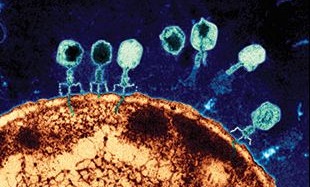 When a mobile genetic element (MGE) inserts into the host genome, it inevitably modifies that genome, typically using an MGE-encoded recombinase (also known as integrase or transposase) as a breaking-and-entering tool. ...Given the ubiquity of MGEs across cellular life forms, it seems extremely unlikely that host organisms would not recruit at least some of these naturally evolved genome manipulation tools in order to exploit their remarkable capacities for their own purposes.
When a mobile genetic element (MGE) inserts into the host genome, it inevitably modifies that genome, typically using an MGE-encoded recombinase (also known as integrase or transposase) as a breaking-and-entering tool. ...Given the ubiquity of MGEs across cellular life forms, it seems extremely unlikely that host organisms would not recruit at least some of these naturally evolved genome manipulation tools in order to exploit their remarkable capacities for their own purposes.
 A Movable Defense by Eugene V. Koonin and Mart Krupovic, The Scientist, 1 Jan 2015. A Movable Defense by Eugene V. Koonin and Mart Krupovic, The Scientist, 1 Jan 2015.
 Viruses... is the main related CA webpage. Viruses... is the main related CA webpage.
| 4 Jan 2015 |
What'sNEW about HGT  | | |

 The gene that jumped by Ferris Jabr, Aeon Magazine, 11 Dec 2014. The gene that jumped by Ferris Jabr, Aeon Magazine, 11 Dec 2014.
 Viruses and Other Gene Transfer Mechanisms is a related CA webpage. Viruses and Other Gene Transfer Mechanisms is a related CA webpage.
Semi-relativistic hypervelocity stars could spread life beyond the boundaries of their host galaxies.
 James Guillochon and Abraham Loeb, "The Fastest Unbound Stars in the Universe" [abstract], arXiv:1411.5022 [astro-ph.GA], Nov 2014. James Guillochon and Abraham Loeb, "The Fastest Unbound Stars in the Universe" [abstract], arXiv:1411.5022 [astro-ph.GA], Nov 2014.
 James Guillochon and Abraham Loeb, "Observational Cosmology With Semi-Relativistic Stars" [abstract], arXiv:1411.5030 [astro-ph.CO], Nov 2014. James Guillochon and Abraham Loeb, "Observational Cosmology With Semi-Relativistic Stars" [abstract], arXiv:1411.5030 [astro-ph.CO], Nov 2014.
 Stars Travelling Close to the Speed of Light Could Spread Life Through the Universe..., The Physics arXiv Blog, 28 Nov 2014. Stars Travelling Close to the Speed of Light Could Spread Life Through the Universe..., The Physics arXiv Blog, 28 Nov 2014.
 Thanks, Theodore Rigley. Thanks, Theodore Rigley.
 Planet hunters plot course for habitable worlds by Alexandra Witze, doi:10.1038/517008a, Nature, 1 Jan 2015. Planet hunters plot course for habitable worlds by Alexandra Witze, doi:10.1038/517008a, Nature, 1 Jan 2015.
![]()
|

 Ganymede has more ocean water than Earth, according to an analysis of observations from the Hubble Space Telescope. Ganymede's magnetic field... produces two auroral belts (pictured) that can be detected in the ultraviolet. These fluctuate as the big moon orbits within Jupiter's magnetic field. The auroral flucuations are most accurately explained if a conducting (saltwater) ocean on Ganymede also influences them. NASA thinks life might be found there.
Ganymede has more ocean water than Earth, according to an analysis of observations from the Hubble Space Telescope. Ganymede's magnetic field... produces two auroral belts (pictured) that can be detected in the ultraviolet. These fluctuate as the big moon orbits within Jupiter's magnetic field. The auroral flucuations are most accurately explained if a conducting (saltwater) ocean on Ganymede also influences them. NASA thinks life might be found there.

 A primitive ocean on Mars held more water than Earth's Arctic Ocean, according to NASA scientists. Using ground-based telescopes, NASA can see that the ratio of deuterium to hydrogen in water on Mars varies from place to place. And these D/H ratios are different from that in martian meteorites recovered on Earth. The differences are best explained if Mars lost a large volume of water to space over millions of years.
A primitive ocean on Mars held more water than Earth's Arctic Ocean, according to NASA scientists. Using ground-based telescopes, NASA can see that the ratio of deuterium to hydrogen in water on Mars varies from place to place. And these D/H ratios are different from that in martian meteorites recovered on Earth. The differences are best explained if Mars lost a large volume of water to space over millions of years.
 Astronomers assumed that such regions would therefore be devoid of such complex organics. The ALMA observations, however, proved the contrary: Complex organic molecules are abundant in the CND.... CND stands for circumnuclear disk, a ring of dust and gas surrounding, in this case, the supermassive black hole at the center of galaxy NGC 1068 (pictured). Seen there by researchers using the Atacama Large Millimeter/ submillimeter Array (ALMA) are complex organic molecules such as cyanoacetylene (HC3N) and acetonitrile (CH3CN), carbon monosulfide (CS) and methanol (CH3OH). Such complex carbon-based molecules are thought to be easily obliterated by the strong X-rays and ultraviolet (UV) photons that permeate the environment surrounding supermassive black holes. The new ALMA data indicate, however, that pockets of calm exist even in this tumultuous region, most likely due to dense areas of dust and gas that shield molecules from otherwise lethal radiation. As usual, the possibility that the complex organics are degraded byproducts of life is not mentioned.
Astronomers assumed that such regions would therefore be devoid of such complex organics. The ALMA observations, however, proved the contrary: Complex organic molecules are abundant in the CND.... CND stands for circumnuclear disk, a ring of dust and gas surrounding, in this case, the supermassive black hole at the center of galaxy NGC 1068 (pictured). Seen there by researchers using the Atacama Large Millimeter/ submillimeter Array (ALMA) are complex organic molecules such as cyanoacetylene (HC3N) and acetonitrile (CH3CN), carbon monosulfide (CS) and methanol (CH3OH). Such complex carbon-based molecules are thought to be easily obliterated by the strong X-rays and ultraviolet (UV) photons that permeate the environment surrounding supermassive black holes. The new ALMA data indicate, however, that pockets of calm exist even in this tumultuous region, most likely due to dense areas of dust and gas that shield molecules from otherwise lethal radiation. As usual, the possibility that the complex organics are degraded byproducts of life is not mentioned.

 After rendezvous, the Rosetta spacecraft moved ...to a bound orbit only ~10 km away. This early period of the mission has revealed previously unseen details of a comet nucleus, as Rosetta's instruments recorded measurements that were once impossible. This issue of Science contains the first published scientific results from Rosetta at comet 67P.
After rendezvous, the Rosetta spacecraft moved ...to a bound orbit only ~10 km away. This early period of the mission has revealed previously unseen details of a comet nucleus, as Rosetta's instruments recorded measurements that were once impossible. This issue of Science contains the first published scientific results from Rosetta at comet 67P.
 Rocks photographed by NASA's Curiosity rover on Mars resemble biologically formed ones on Earth, according to geobiologist Nora Noffke of Old Dominion University in Virginia. In a paper in Astrobiology, Noffke carefully compares sedimentary structures in Mars' Gillespie Lake outcrop with structures shaped by microbes on Earth. The study is worth a look:
Rocks photographed by NASA's Curiosity rover on Mars resemble biologically formed ones on Earth, according to geobiologist Nora Noffke of Old Dominion University in Virginia. In a paper in Astrobiology, Noffke carefully compares sedimentary structures in Mars' Gillespie Lake outcrop with structures shaped by microbes on Earth. The study is worth a look: When a mobile genetic element (MGE) inserts into the host genome, it inevitably modifies that genome, typically using an MGE-encoded recombinase (also known as integrase or transposase) as a breaking-and-entering tool. ...Given the ubiquity of MGEs across cellular life forms, it seems extremely unlikely that host organisms would not recruit at least some of these naturally evolved genome manipulation tools in order to exploit their remarkable capacities for their own purposes.
When a mobile genetic element (MGE) inserts into the host genome, it inevitably modifies that genome, typically using an MGE-encoded recombinase (also known as integrase or transposase) as a breaking-and-entering tool. ...Given the ubiquity of MGEs across cellular life forms, it seems extremely unlikely that host organisms would not recruit at least some of these naturally evolved genome manipulation tools in order to exploit their remarkable capacities for their own purposes.

 This is a fascinating set of evolution experiments, evolutionary biologist Richard Lenski told The Scientist. Their experiments show how a biological function ...can re-evolve after the deletion of a seemingly critical gene. At Michigan State University, Lenski himself initiated the best-known quarantined experiments with bacteria. Among many objectives, the experimenters hope to observe the invention of new genetic programs.
This is a fascinating set of evolution experiments, evolutionary biologist Richard Lenski told The Scientist. Their experiments show how a biological function ...can re-evolve after the deletion of a seemingly critical gene. At Michigan State University, Lenski himself initiated the best-known quarantined experiments with bacteria. Among many objectives, the experimenters hope to observe the invention of new genetic programs.

